1951 - 1956 Bugatti Type 101 (03) (03)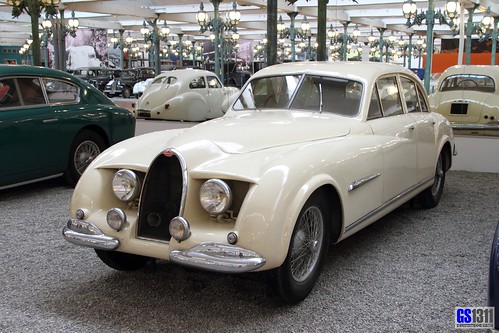
Image by Georg Schwalbach (GS1311)
In order to restart Bugatti, a new car was needed for the 1950s. The result was the 1951 Type 101. An evolution of the Type 57, it is considered by many to be the last true Bugatti car, until 1956; with just seven produced. Powered by the 3.3 L (3257 cc/198 in³) straight-8 from the Type 57. The seven chassis were bodied by four different coachbuilders:Gangloff, Guillore, Antem, and Virgil Exner/Ghia.
Six Type 101 chassis were built after an initial converted Type 57 chassis prototype. At least two more Type 57s were also converted to Type 101 specifications, making a total of nine Type 101 cars produced.
The last Type 101 was built in 1965 by Ghia designed by Virgil Exner for the last remaining Type 101 chassis as an attempt to revive the marque. It was exhibited at the Turin Motor Show, but financing could not be arranged and production plans were scrapped. Exner owned the car for many years, and it has lately appeared in public at the Pebble Beach Concours d'Elegance.
The Antem Coupé was exhibited at the 1951 Paris Salon de l'Automobile but not sold until 1958. Owned by Bill Harrah and Nicolas Cage and now in the O'Quinn Collection since 2006.
(Wikipedia)
- - -
Der Bugatti Type 101 (auch: Bugatti T 101) war der letzte Personenwagen, den der französische Automobilhersteller Bugatti entwickelte und baute. Mit ihm unternahm das traditionsreiche Elsässer Werk den Versuch, nach dem Zweiten Weltkrieg die reguläre Automobilproduktion wieder aufzunehmen. Es gelang Bugatti allerdings nicht, an die Erfolge der Vorkriegszeit anzuknüpfen. Der T 101 wurde nur in sechs Exemplaren hergestellt; daneben erhielten einige ältere Bugattis nachträglich Karosserien im Stil des T 101.
Das vierte Serienchassis des T 101 erhielt im Sommer 1951 eine Coupé-Karosserie von dem in Neuilly-sur-Seine ansässigen Karossier Antem. Der Sportwagen hatte eine niedrige Gürtellinie, eine sehr lange Motorhaube und eine knappe, kuppelartige Fahrgastzelle. Die vordere Verglasung war in die Fahrzeugseite hineingezogen, stellte aber keine Panoramascheibe im eigentlichen Sinn dar. Sie bestand vielmehr aus vier Einzelteilen. Bugatti stellte das Antem-Coupé zusammen mit einem Gangloff-Cabriolet auf dem Pariser Automobilsalon 1951 erstmals öffentlich aus. In den folgenden Jahrzehnten ging das Auto durch mehrere Sammlerhände; in den 1990er-Jahren gehörte es unter anderem dem Schauspieler Nicolas Cage.
(Wikipedia)
1951 - 1956 Bugatti Type 101 (05)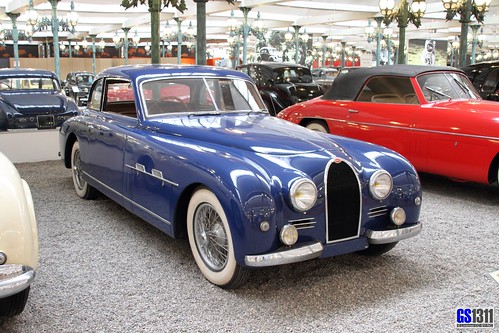
Image by Georg Schwalbach (GS1311)
In order to restart Bugatti, a new car was needed for the 1950s. The result was the 1951 Type 101. An evolution of the Type 57, it is considered by many to be the last true Bugatti car, until 1956; with just seven produced. Powered by the 3.3 L (3257 cc/198 in³) straight-8 from the Type 57. The seven chassis were bodied by four different coachbuilders:Gangloff, Guillore, Antem, and Virgil Exner/Ghia.
Six Type 101 chassis were built after an initial converted Type 57 chassis prototype. At least two more Type 57s were also converted to Type 101 specifications, making a total of nine Type 101 cars produced.
The last Type 101 was built in 1965 by Ghia designed by Virgil Exner for the last remaining Type 101 chassis as an attempt to revive the marque. It was exhibited at the Turin Motor Show, but financing could not be arranged and production plans were scrapped. Exner owned the car for many years, and it has lately appeared in public at the Pebble Beach Concours d'Elegance.
The Antem Coupé was exhibited at the 1951 Paris Salon de l'Automobile but not sold until 1958. Owned by Bill Harrah and Nicolas Cage and now in the O'Quinn Collection since 2006.
(Wikipedia)
- - -
Der Bugatti Type 101 (auch: Bugatti T 101) war der letzte Personenwagen, den der französische Automobilhersteller Bugatti entwickelte und baute. Mit ihm unternahm das traditionsreiche Elsässer Werk den Versuch, nach dem Zweiten Weltkrieg die reguläre Automobilproduktion wieder aufzunehmen. Es gelang Bugatti allerdings nicht, an die Erfolge der Vorkriegszeit anzuknüpfen. Der T 101 wurde nur in sechs Exemplaren hergestellt; daneben erhielten einige ältere Bugattis nachträglich Karosserien im Stil des T 101.
Das vierte Serienchassis des T 101 erhielt im Sommer 1951 eine Coupé-Karosserie von dem in Neuilly-sur-Seine ansässigen Karossier Antem. Der Sportwagen hatte eine niedrige Gürtellinie, eine sehr lange Motorhaube und eine knappe, kuppelartige Fahrgastzelle. Die vordere Verglasung war in die Fahrzeugseite hineingezogen, stellte aber keine Panoramascheibe im eigentlichen Sinn dar. Sie bestand vielmehr aus vier Einzelteilen. Bugatti stellte das Antem-Coupé zusammen mit einem Gangloff-Cabriolet auf dem Pariser Automobilsalon 1951 erstmals öffentlich aus. In den folgenden Jahrzehnten ging das Auto durch mehrere Sammlerhände; in den 1990er-Jahren gehörte es unter anderem dem Schauspieler Nicolas Cage.
(Wikipedia)
1914 Bugatti Type 17 (03)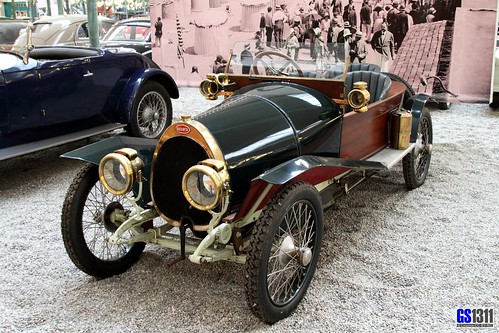
Image by Georg Schwalbach (GS1311)
The Type 13 was the first real Bugatti car. Production of the Type 13 and later Types 15, 17, 22, and 23, began with the company's founding in 1910 and lasted through 1920 with 435 examples produced. Most road cars used an 8-valve engine, though five Type 13 racers had 16-valve heads, one of the first ever produced. The road cars became known as "pur-sang" ("thoroughbred") in keeping with Ettore Bugatti's feelings for his designs.
The car was brought back after World War I with multi-valve engines to bring fame to the marque at Brescia. The production "Brescia Tourer" also brought in much-needed cash.
The Type 17 used a 2550 mm (100.4 in) wheelbase. It shared its hexagonal radiator and rear springs with the Type 15.
(Wikipedia)
1914 Bugatti Type 17 (01)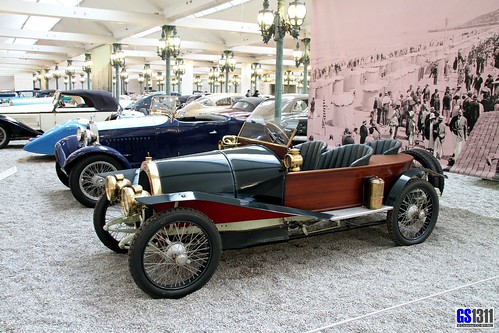
Image by Georg Schwalbach (GS1311)
The Type 13 was the first real Bugatti car. Production of the Type 13 and later Types 15, 17, 22, and 23, began with the company's founding in 1910 and lasted through 1920 with 435 examples produced. Most road cars used an 8-valve engine, though five Type 13 racers had 16-valve heads, one of the first ever produced. The road cars became known as "pur-sang" ("thoroughbred") in keeping with Ettore Bugatti's feelings for his designs.
The car was brought back after World War I with multi-valve engines to bring fame to the marque at Brescia. The production "Brescia Tourer" also brought in much-needed cash.
The Type 17 used a 2550 mm (100.4 in) wheelbase. It shared its hexagonal radiator and rear springs with the Type 15.
(Wikipedia)
1914 Bugatti Type 17 (02)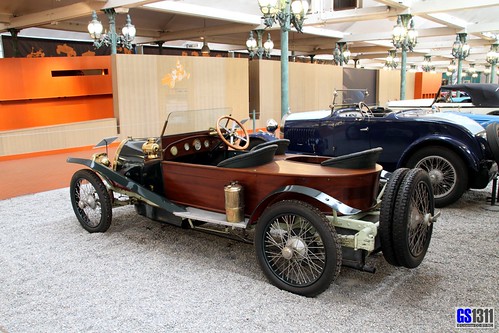
Image by Georg Schwalbach (GS1311)
The Type 13 was the first real Bugatti car. Production of the Type 13 and later Types 15, 17, 22, and 23, began with the company's founding in 1910 and lasted through 1920 with 435 examples produced. Most road cars used an 8-valve engine, though five Type 13 racers had 16-valve heads, one of the first ever produced. The road cars became known as "pur-sang" ("thoroughbred") in keeping with Ettore Bugatti's feelings for his designs.
The car was brought back after World War I with multi-valve engines to bring fame to the marque at Brescia. The production "Brescia Tourer" also brought in much-needed cash.
The Type 17 used a 2550 mm (100.4 in) wheelbase. It shared its hexagonal radiator and rear springs with the Type 15.
(Wikipedia)





0 comments:
Post a Comment